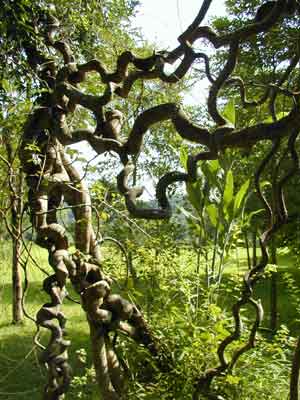 |
|
Fluttering Giant Climbers |
Vine plants are kinds of climbing plants that need the support of other plants or rocks or special supporting objects to provide underprops, and they scatter in most areas on the globe. So far as the textures of vine plants are concerned, they can be divided into herbal and woody vine plants. Herbal vine plants mainly scatter in temperate zones. In the tropical rain forests, woody vine plants have various capacities in climbing; some make use of the absorbing roots growing on the stalks or branches, such as
Tetrastigma planicaulum, which climbs along the tree trunks of other trees; some use their rolling musts to climb up along the branches of trees, such as
Hodgsania macrocarpa; some use their thorns and thrust towards the branches and leaves of other trees and spaces, such as various of
Calamus spp.; and some make use of their spiral properties, and entangle the trunks of other trees when climbing up, such as
Mucuna macrocarpa etc.
What makes people surprise is that, some vine plants are as thick as arms or legs; and they can fly from the ground surface to trees as tall as 20-30 meters. Some of the thick vines suspend under the canopies of tall trees; some even entangle themselves and form into rings of different sizes. People could also see monkeys swing in-between trees on the vines relaxingly. People always wonder how they climb to such heights, after careful observation, they will find that the vines also climb gradually along certain paths. First, they will climb on small trees, then they will climb up to middle and tall trees. In this process, if the trees they are climbing on are dead, the vines will fall down to the ground or lower trees together with the fallen tree. The falling vines will begin to grow again and will start a new journey of climbing. Climbing vines will repeat this process many times until they can form magnificent views as have mentioned above.
Many woody vine plants like sunlight. However, they also have shade-resistant properties before they climb onto tops of other trees. The sprouts of their leaves can stay in dormant state for quite a long time; during this time, their branches, flowers and fruits are less. Their nutritious substances all gather in the main stalks or tendrils, which will climb up for their dear lives. After they climb on the canopies of other trees and begin to receive sufficient sunlight, they will grow out branches and leaves immediately or even cover the top of the trees that are supporting them; and then they will begin to blossom and grow fruits. From this, we can see that, in order to survive and to develop, these vine plants, before they stick themselves out, are quite stubborn and patient in their survival strategies. We can also assume that whether or not their armpit sprouts will get rid of dormant state is at the disposal of the sunlight. The light-sensing substances in the vine bodies may have the ability to sense sunlight and may also decide the amount and direction of the hormone supply for the armpit sprouts. As a result, vines in that direction can get rid of the dormant state in growth. Besides, the stalks and tendrils of these vine plants also have quite advanced conveying tissues and sufficient water pressures, because they can even supply sufficient water and nutrition towards branches, flowers and fruits dozens of meters or even hundreds of meters away to ensure their fast growth.
 
|

